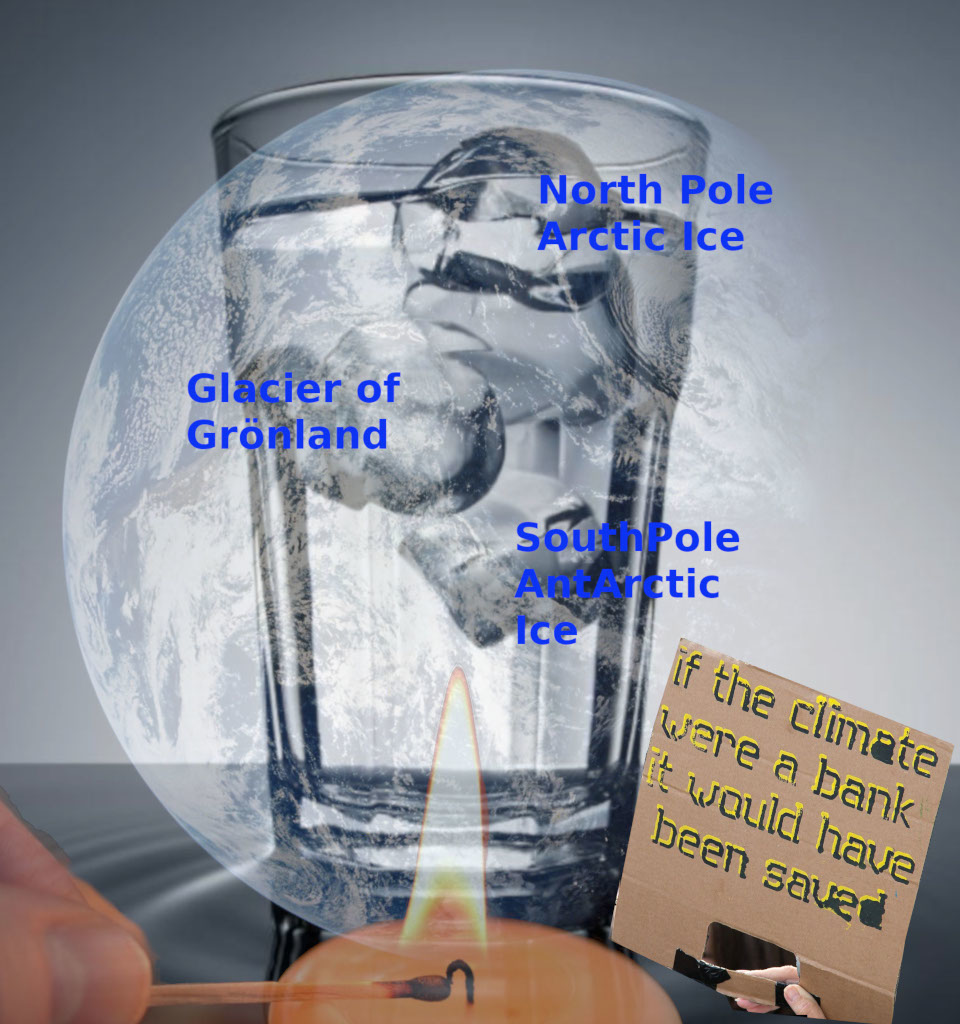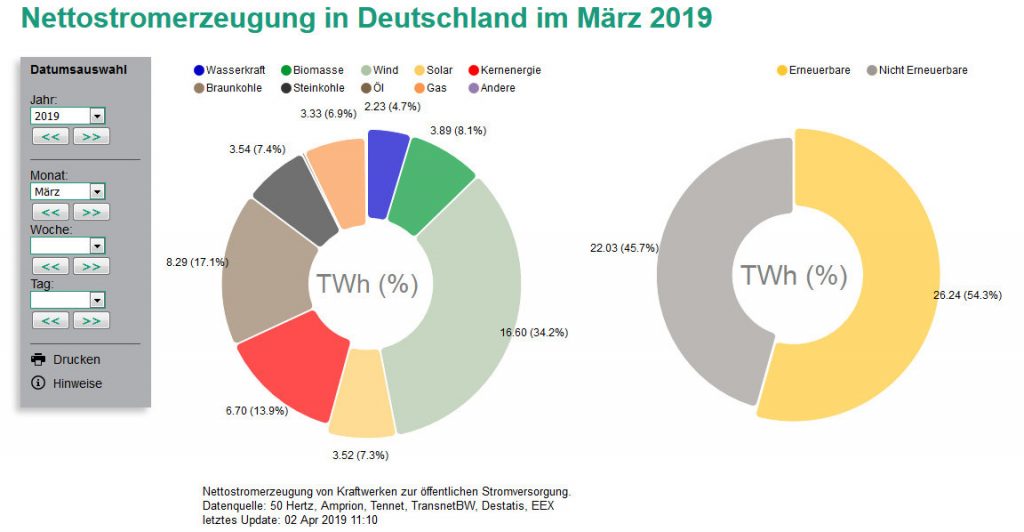Evtl. DER WICHTIGSTE ARTIKEL zum Klimawandel EVER!
Untertitel: was haben die Nord- und Süd-Polkappen mit dem Klima in Europa zu tun?
-> https://www.heise.de/tp/news/Was-kommt-nach-der-Polschmelze-2027223.html
Um Wasser vom flüssigen in den festen (Eis) Aggregatzustand zu überführen wird eine erhebliche Menge an Energie benötigt.
Pro Liter Wasser sind das knapp 334 Kilojoule oder 80 Kilokalorien.
Um sich eine Vorstellung zu machen – mit einer Energie von 80 Kilokalorien könnte man einen Liter Wasser von Zimmertemperatur auf 100 Grad erhitzen. (Quelle)
D.h. die Erderwärmung wurde durch die Eis-Pole aufgehalten – wie die Erwärmung von 3x Eiswürfeln in einem Glas Cola/Rum/Whatever.
Sind diese Eiswürfel geschmolzen, wird „die Soße“ schlagartig wärmer d.h. wird es auf diesem Planeten / auch in Europa um das Jahr 2040 schlagartig wärmer?
„Hornsdale Power Reserve“ oder auch „die größte Batterie“ Australiens, stabilisiert nicht nur das Netz, sondern sorgt scheinbar auch für sinkende Strompreise in Australien?
„Reserveleistung durch den Akku auf 154 Euro pro MWh gesunken. Die Netzbetreiber haben dadurch zahlreiche Millionen eingespart – was zu niedrigeren Stromrechnungen für die Einwohner führt“
Voraussetzung: Netzbetreiber gibt Einsparung an Kunden weiter!!!
Stand der Energiewende: Ein Wasserkraftwerk mit Fischtreppe bekommt in BRD 11Cent, eine Solaranlage 2011 28,74Cent, ein Windrad vielleicht 7-8Cent… was zahlt der „Kunde“ 26Cent und mehr… wo bleibt die Differenz? Stromsteuer und die 4x Netz-Betreiber!!!
Ich befürchte aber dass die Energiekonzerne ihre „Ersparnisse“ eher ungern an den Kunden weiter geben. Sondern wie so oft im „Zwischenhandel“ einfach behalten.
Mit 129 MegaWattStunden ist diese die größte Lithium-Ion Batterie der welt, aber nur die drittgrößte Batterie der Welt, davor kommen noch zwei Sodium-sulphur Batterien in Japan.
„South Australia’s Tesla battery on track to make back a third of cost in a year“
„World’s largest lithium battery cost $90.6m but revenue is healthy, according to documents filed by French renewable company Neoen“
„capital cost of €56m or A$90.6m and generated €8.1m, or A$13.1m, in revenue from network services in the six months to 30 June 2018.
Almost $2m of that was from its 10-year contract with the SA government to provide reserve capacity for the state’s electricity network, which is worth $4m a year.“
„It also made €6.7m, or A$10.8, from the sale of stored electricity.“
(src)
Live Data:
src: https://embed.global-roam.com/containers/a1a0813d-5e10-49b1-b9fa-b4de5323a96a
Tesla’s big battery in Australia is starting an energy storage movement
129 MWh storage in Australia
Tesla, Inc. built the Hornsdale Power Reserve adjacent to the Hornsdale wind farm. As of December 2017 it is promoted as the largest lithium-ion battery in the world.[37] Its 100 MW output capacity is contractually divided into two sections: 70 MW running for 10 minutes, and 30 MW with a 3 hour capacity.[38] Samsung 21700-size cells are used.[39]
It is operated by Tesla and provides a total of 129 megawatt-hours (460 GJ) of storage capable of discharge at 100 megawatts (130,000 hp) into the power grid. The system helps to prevent load-shedding blackouts[40][41] and provide stability to the grid (grid services)[42] while other generators can be started in the event of sudden drops in wind or other network issues. It was built in less than 100 days counting from 29 September 2017,[43][44] when a grid connection agreement was signed with ElectraNet, and some units were operational.[40] The battery construction was completed and testing began on 25 November 2017. It was connected to the grid on 1 December 2017.[45] During two days in January 2018 where South Australia was hit by price spikes, the battery made its owners an estimated 1M AUD as they sold power from the battery to the grid for a price of around 14k AUD/MWh.[46]
similar projects:
Also Australia:
ElectraNet’s 30 MW 8MWh large-scale battery at Dalrymple substation will demonstrate how energy storage can strengthen the grid and improve reliability for the lower Yorke Peninsula. The battery energy storage system is being built next to, and connected to, ElectraNet’s Dalrymple substation, seven kilometres south-west of Stansbury.“
with live data: https://www.escri-sa.com.au/ and here: https://www.escri-sa.com.au/data/?indicatorA=WATT_P.GEN.WP_1.MW&indicatorB=WEATHER.PROP.DALRYM.A1WS
Largest grid batteries
| Name | Commissioning date | Energy (MWh) | Power (MW) | Duration (hours) | Type | Country | Refs |
|---|---|---|---|---|---|---|---|
| Buzen Substation | 3 March 2016 | 300 | 50 | 6 | Sodium-sulphur | Japan | [47][48][49] |
| Rokkasho, Aomori | 245 | 34 | 7 | Sodium-sulphur | Japan | [50][51] | |
| Hornsdale Power Reserve | 1 December 2017 | 129 | 100 | 3 | Lithium-ion | Australia | [52][53][41][40][54] |
| Escondido Substation | 24 February 2017 | 120 | 30 | 4 | Lithium-ion | USA | [55][56][57][58] |
| Pomona Substation | January 2017 | 80 | 20 | 4 | Lithium-ion | USA | [59][56] |
| Mira Loma Substation | 30 Jan. 2017 | 80 | 20 | 4 | Lithium-ion | USA | [60][61][62] |
| Tesla Solar Plant | 8 March 2017 | 52 | 13 | 5 | Lithium-ion | USA | [63][64] |
| Stocking Pelham facility | July 2018 | 50 | 50 | Lithium-ion | United Kingdom | [28][29] | |
| Jardelund | June 2018 | 50 | 48 | Lithium-ion | Germany | [65][66] | |
| Minamisōma Substation | February 2016 | 40 | 40 | Lithium-ion | Japan | [67] |
https://en.wikipedia.org/wiki/Battery_storage_power_station
Über 50% Erneuerbarer Stromerzeugung im März 2019 über German clean power output ‚tops 50%‘
Walmart – „DER“ Laden in USA, doppelt so viel Umsatz wie Amazon (2017) – installiert Solar auf 6% seiner Laden-Dächer, warum? Günstiger als Strom einzukaufen!
„‘We’re not in the sustainability business, we’re in real estate.’ Wal-Mart’s green maven David Ozment. (Photo by Matthew Mahon, for Forbes.)
Wal-Mart has installed 105 megawatts of solar panels–enough to power about 20,000 houses–on the roofs of 327 stores and distribution centers (about 6% of all their locations). That’s enough to make Wal-Mart the single biggest commercial solar generator in the country. And it intends to double its number of arrays by 2020.“
https://www.forbes.com/sites/christopherhelman/2015/11/04/walmarts-everyday-renewable-energy/



